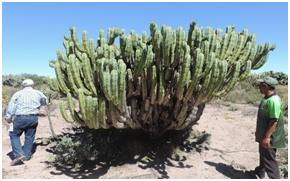Reforestación con esquejes de Myrtillocactus geometrizans (Mart. ex Pfeiff.) Console. en Guanajuato
DOI:
https://doi.org/10.29298/rmcf.v13i70.1264Resumen
Para conservar los recursos naturales se ha propuesto la reforestación con especies nativas que tengan una utilidad. Ejemplo de lo anterior es Myrtillocactus geometrizans, conocido comúnmente como garambullo; esta cactácea crece en zonas áridas de México y su fruto se considera como un alimento nutraceútico por su alto contenido de compuestos fitoquímicos. Por ello, la finalidad del proyecto aquí descrito consistió en evaluar dos sistemas de reforestación directa, con esquejes y con esquejes desarrollados en vivero. Se seleccionaron ejemplares de acuerdo con las características de los frutos y condiciones de sanidad de la planta; como resultado se obtuvieron 1 000 esquejes para usarlos en reforestación directa y 1 000 esquejes para cultivarlos en vivero. Fueron cinco viveros rústicos bajo las mismas condiciones de manejo para producir planta de garambullo; se registró el desarrollo de estructuras nuevas (como raíces) y vigor del esqueje. La reforestación se realizó en la comunidad de El Garabatillo, municipio Dolores Hidalgo, Guanajuato, donde crece la especie de forma natural. En el caso de la reforestación directa, la supervivencia de la planta fue de 70.3 % con una buena evolución de los ejemplares, mientras que la supervivencia de la planta en vivero fue de 90.6 % con un buen desarrollo radicular al momento de la plantación en campo. Se determinó que ambos sistemas (plantación directa y desarrollo en vivero) son confiables para reforestar predios con garambullo, sobre todo en regiones donde la especie existe en forma natural.
Descargas
Citas
Bravo H., H. y H. Sánchez M. 1978. Las cactáceas de México. Vol. 1. Universidad Nacional Autónoma de México. México, D. F., México. 743 p.
Comisión Nacional Forestal (Conafor). 2010. Prácticas de reforestación: manual básico. Conafor, Semarnat. Zapopan, Jal., México. 64 p.
Guzmán-Maldonado, S. H., G. Herrera-Hernández, D. Hernández-López, R. Reynoso-Camacho, A. Guzmán-Tovar, F. Vaillant and P. Brat. 2010. Physicochemical, nutritional and functional characteristics of two underutilised fruit cactus species (Myrtillocactus) produced in central Mexico. Food Chemistry 121 (2): 381-386. Doi: 10.1016/j.foodchem.2009.12.039. DOI: https://doi.org/10.1016/j.foodchem.2009.12.039
Instituto Nacional de estadística, Geografía e Informática (INEGI). 2017. Anuario estadístico y geográfico de Guanajuato 2017. INEGI. Aguascalientes, Ags., México. 604 p.
Meyrán, G. J. y L. López C. 2003. Las Crassuláceas de México. Sociedad Mexicana de Cactología, A.C. México, D. F., México. 234 p.
Monreal-Vargas, C. T., E. Espitia M. y O. Escandón Q. 2014. Hongos patógenos del garambullo Myrtillocactus geometrizan (Mart. ex. Pfeiff) Console en Mexquitic de Carmona, San Luis Potosí, México. Revista Iberoamericana de Ciencias 1(6):45-59. http://www.reibci.org/publicados/2014/noviembre/0600118.pdf (20 de diciembre de 2021).
Moreno-Hernández, A., N. Estrella-Chulim, S. Escobedo-Garrido, A. Bustamante-González y P. W. Gerritsen 2011. Prácticas de manejo agronómico para la sustentabilidad: características y medición en Agave tequilana Weber en la región Sierra de Amula, Jalisco. Tropical and Subtropical Agroecosystems 14:159–169. Doi: 10.29312/remexca.v8i18.216. DOI: https://doi.org/10.29312/remexca.v8i18.216
Neri-Luna, C., E. Pimienta-Barrios y C. Robles M. 1993. Cambios fisiológicos durante el proceso de senescencia en cladodios jóvenes de nopal (Opuntia ficus-indica L. Miller). Agrociencia 4(1):7-18. https://www.researchgate.net/publication/289507596_Cambios_fisiologicos_durante_el_proceso_de_senescencia_en_cladodios_jovenes_de_nopal_Opintia_ficus-indica_L_Miller (15 de noviembre de 2021).
Osuna F., H. R., A. M. Osuna F. y A. Fierro A. 2016. Manual de propagación de plantas superiores. Universidad Nacional Autónoma de México, Universidad Autónoma Metropolitana. Ciudad de México, CDMX., México. 90 p.
Terrones, R. T. del R. L., C. González S. y S. A. Ríos R. 2004. Arbustivas nativas de uso múltiple en Guanajuato. Libro técnico Núm. 2. INIFAP, Campo Experimental Bajío. Celaya, Gto., México. 216 p.
Terrones R., T., V. Partida P. F., C. González S. y M. Tovar H. 2014. Plantas Silvestres en el Paisaje Urbano del Municipio de León, Gto. Publicación Técnica del Instituto Municipal de Planeación (IMPLAN). León, Gto., México. 211 p.
Villavicencio G., E. E., A. González C., A. Arredondo G., L. Iracheta D., S. Camparan S. y R. Casique V. 2011. Micropropagación de Turbinacarpus knuthianus (Boed.) John & Riha Cactacea ornamental del Desierto Chihuahuense, en estado de riesgo. Revista Mexicana de Ciencias Forestales. 2(6): 37-54. Doi:10.29298/rmcf.v2i6.573. DOI: https://doi.org/10.29298/rmcf.v2i6.573

Descargas
Publicado
Cómo citar
Número
Sección
Licencia

Esta obra está bajo una licencia internacional Creative Commons Atribución-NoComercial 4.0.
Los autores que publiquen en la Revista Mexicana de Ciencias Forestales aceptan las siguientes condiciones:
De acuerdo con la legislación de derechos de autor, la Revista Mexicana de Ciencias Forestales reconoce y respeta el derecho moral de los autores, así como la titularidad del derecho patrimonial, el cual será cedido a la revista para su difusión en acceso abierto.
Todos los textos publicados por la Revista Mexicana de Ciencias Forestales –sin excepción– se distribuyen amparados bajo la licenciaCreative Commons 4.0 Atribución-No Comercial (CC BY-NC 4.0 Internacional), que permite a terceros utilizar lo publicado siempre que mencionen la autoría del trabajo y a la primera publicación en esta revista. (no permite el uso comercial)
Los autores pueden realizar otros acuerdos contractuales independientes y adicionales para la distribución no exclusiva de la versión del artículo publicado en la Revista Mexicana de Ciencias Forestales (por ejemplo, incluirlo en un repositorio institucional o darlo a conocer en otros medios en papel o electrónicos) siempre que indique clara y explícitamente que el trabajo se publicó por primera vez en la Revista Mexicana de Ciencias Forestales.
Para todo lo anterior, los autores deben remitir el formato de carta-cesión de la propiedad de los derechos de la primera publicación debidamente requisitado y firmado por los autores/as. Este formato debe ser remitido en archivo PDF al correo: editorial.forestal@inifap.gob.mx
Esta obra está bajo una licencia de Creative Commons Reconocimiento-No Comercial 4.0 Internacional.





